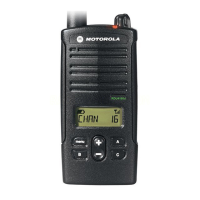MTR3000 Power Amplifier: Specifications 4-3
4.2 Specifications
Table 4-1 shows the specifications of MTR3000 Base Station/Repeater’s Power Amplifier (PA).
4.3 Functional Theory Of Operation
The Power Amplifier (PA) is designed for continuous-duty operation across each specified band and
power level. All PA contain a multi-stage power amplifier board at the input (RF Board), a circulator
with isolation load termination, a low-pass filter/directional coupler at the output (Output Board), and
a DC Distribution Board incorporating circuitry for diagnostics and RF power control. The PA and its
sub-circuits are broad-band devices and require no manual tuning or alignment to operate over the
specified conditions.
The main interface between the PA and the rest of the base station/repeater is through the DC
Distribution Board. The DC distribution board contains the PA external I/O’s that connects to the
power supply directly through a cable and to the control module through a cable to the backplane
interface board. These I/O’s are used to distribute the DC supply buses (28.6 V and 14.2 V nominal)
from the power supply to within the PA as well as the various signals used for the control of the PA
from the SCM such as the SPI bus signals, PA enable, and the reset line.
The DC Distribution Board contains the SPI circuitry as well as metering circuitry used by both SW
and internal PA HW for determining when fault conditions are present and take appropriate action
when needed. A brief description of the PA SPI devices is shown below.
• Customer Programmable Logic Device (CPLD): Main PA SPI interface, with all other PA SPI
devices connected through this device
• Non-Volatile Memory (NVM): Used to store calibration data and identification information
• Digital to Analog Converter (DAC): Converts SW digital signals to analog within the PA. This
controls the PA fan, power control circuit, and some other circuits within the PA
• Analog to Digital Converter (ADC): Converts analog signals within the PA to digital for SW
interface. These signals are used by SW for HW metering
Table 4-1 Specifications of Power Amplifier
Parameter
Specification
UHF 800/900 MHz
Operational Frequency Range 403–470 MHz (UHF R1) or
470–524 MHz (UHF R2)
851–941 MHz
Minimum Input Return Loss (Tx mode) 7 dB 10 dB
Rated RF Output Power Range 8–100 W 8–100 W
Rated RF Input Power Range 9.8–14 dBm 12.8–18.5 dBm
28.6 V Supply Nominal Voltage (AC Power) 28.6 V (+/- 4%) 28.6 V (+/- 4%)
14.2 V Supply Nominal Voltage 14.2 V (+/- 3%) 14.2 V (+/- 3%)
28.6 V Supply Maximum Current Draw 12.6 A 12.6 A
14.2 V Supply Maximum Current Draw 2.0 A 2.0 A
Maximum Standby Power Consumption 1.2 W 1.5 W

